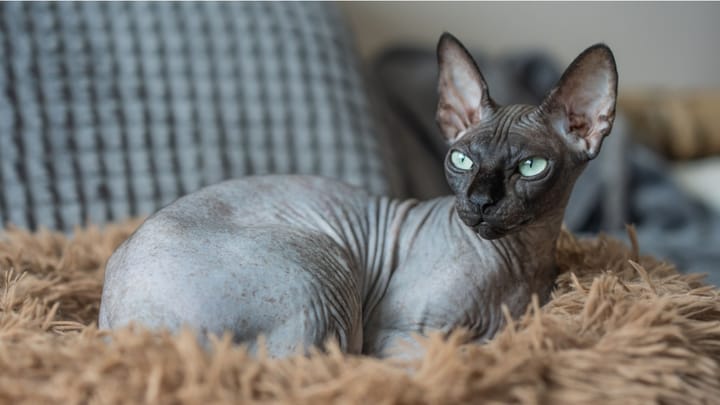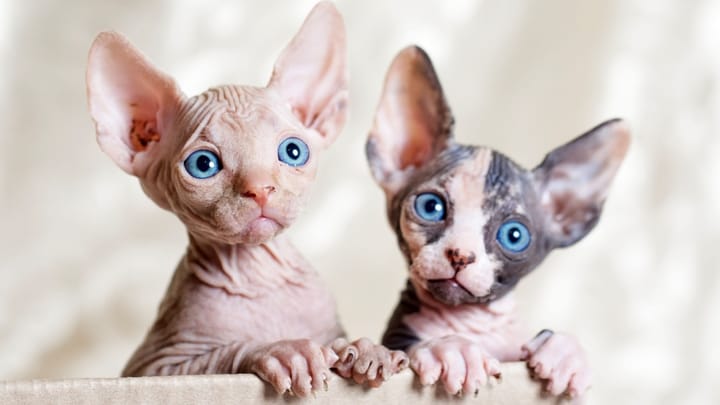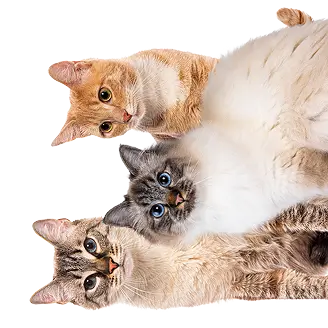Sphynx
Other name: Canadian Sphynx


All sorts of rumors have circulated about the origins of this hairless cat. It has been said to come from dubious genetic experiments and even the victim of nuclear radiation from the Chernobyl power station ... In fact, a genetic mutation is at the origin of the Sphynx’s lack of hair. It’s name comes from the fact that it shares some physical traits with the Egyptian sculpture of the same name. Obviously, its nudity is its primary feature, but its lemon-shaped eyes, huge ears and many folds will leave no one indifferent to it. We are automatically either attracted or repelled by this cat’s most peculiar look...
|
Life expectancy |
The Sphynx has a life expectancy of between 8 and 20 years |
|
Temperament |
|
|
Adult size |
Female
Approximately 12 in
Male
Approximately 14 in
|
|
Adult weight |
Female
Between 7 and 11 lb
Male
Between 9 and 13 lb
|
|
Type of coat
Nude or light down |
Naked |
|
Eye colour
Blue, yellow, green, walleyed. The colour of its eyes depends on the colour of its skin. |
Blue
Green
Yellow
Odd-eyed
|
|
Purchase price |
The Sphynx costs between £250 and £800 |
The Sphynx, like humans and unlike other cats, sweats through its skin. It can also sometimes leave stains where it sleeps caused by the sebum from its skin.
More details about the Sphynx
Sphynx: Origins and history
The first hairless cat that was bred was born in the city of Toronto in the province of Ontario in Canada in 1966. The little female was named Plum. People tried to reproduce it with mixed successes. After about 30 years of crossbreeding mainly in France, we obtained the breed as we know it today. In Mexico, very old murals depicting hairless cats have been discovered. Other research suggests that the Aztecs bred and worshipped the Sphynx.
Physical characteristics of the Sphynx
The canadian Sphynx is a lively, muscular and athletic cat.
Sphynx: Characteristics
Sphynx: Behaviour
Breed compatibility Sphynx
Sphynx: Purchase price
On average the price of a Sphynx kitten is between £250 and £800, dependent on lineage, breeder, age and gender. It costs on average £30/month to provide for its needs, to offer a quality diet and ensure it is healthy.
Sphynx: Shedding
None
The Sphynx does not lose any hair. The light down on its skin and slightly hairier parts of the head, ears, paws, scrotum and tail make up its only “fur”.
Sphynx: Grooming
The Sphynx’s skin produces a lot of sebum and, in the absence of hair to absorb it, this sebum can sometimes clog its pores. A bath is recommended a maximum 1 to 2 times per year. Between baths, the use of a wet washcloth to remove excess oil is ideal. A thorough cleaning of the ears on a weekly basis is also recommended since they produce a lot of earwax. Special attention should also be paid between the toes and between pads under the paws, where sebum tends to accumulate. The Sphynx’s skin is also sensitive to sunburn. Be sure to apply sunscreen before prolonged exposure to UV light.
Sphynx: Health
A Sphynx’s life expectancy is between 8 and 20 years.
Due to its lack of fur, this naked cat is sensitive to cold temperatures and will try to find warmth wherever it can (a radiator, an electronic appliance, a hot oven, a sunny window sill, etc.), this can sometimes be problematic for risk of burning itself on hot surfaces or getting sun burnt.
Since this cat has a tendency to eat more in order to maintain its body temperature, you will need to pay particular attention to the quality and quantity of food.
There is a high incidence of heart disease in amongst Sphynxes. Echocardiography remains the diagnostic test of choice for the detection of HCM (hereditary hypertrophic cardiomyopathy). A certain susceptibility to skin disease called papular eruptive mastocytosis or cutaneous papular mastocytosis has been reported in this feline and some other breeds. Another disease called "hereditary myopathy" could also be present. Originally, this condition was identified in the Devon Rex (which contributed to the development of the Sphynx breed).
Special attention should be paid to the blood groups of the breeders in order to avoid haemolytic anemia (neonatal isoerythrolysis) often fatal in kittens.
Do you want a Sphynx cat ?
Frequently asked questions
How much does a Sphynx cat cost?
The price for a Sphynx cat will be on vary between £250 to £800 dependent on lineage, breeder, age and gender. To offer a quality diet and ensure it is healthy to a Sphynx, it would cost approximately £30 per month.
Do Sphynx cats make good pets?
The Sphynx is extremely affectionate (ok it's mainly to keep himself warm that he'll curl up next to you but you still get a cuddle), extremely playful and very curious. This feline appreciates the company of other cats, dogs and children. The Sphynx is definitely a great family pet.
How many years do Sphynx cats live?
The life expectancy of a Sphynx is between 8 to 20 years.
Do Sphynx cats have health problems?
The Sphynx doesn't have any genetics diseases predispositions but can suffer from a few illnesses. This feline can suffer from skin disease called papular eruptive mastocytosis or cutaneous papular mastocytosis. It can also suffer from a heart disease called hypertrophic cardiomyopathy (HCM), it's a condition where the heart muscle thickens.
Can Sphynx cats be left alone?
The Sphynx can be independent and will be alright if left alone for a few hours but they do prefer the company of their owner. If you leave your cat alone for a long amount of time make sure he keeps busy with toys.
Find out more about how long you can leave your cat on its own?







